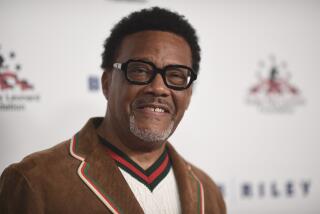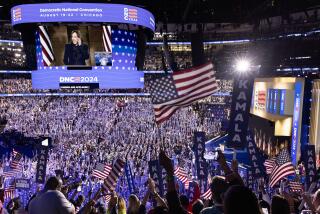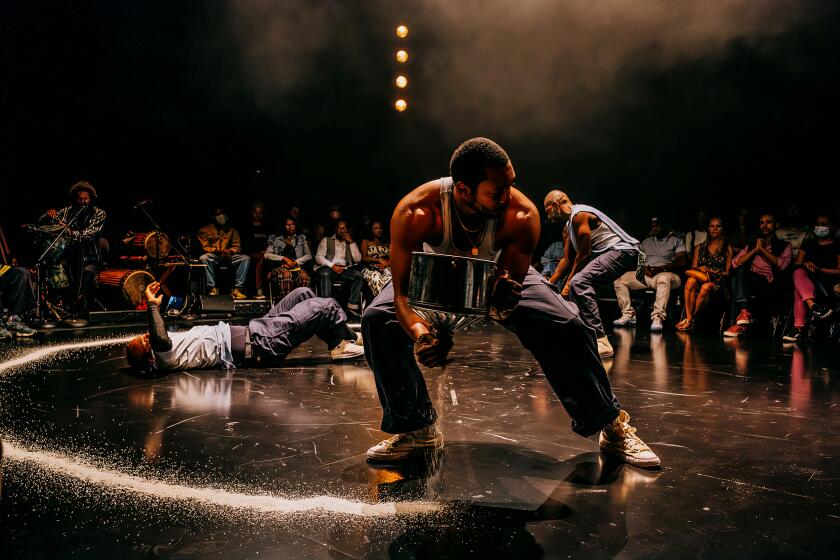COMMISSIONED WORK TO CELEBRATE CENTER
Beethoven’s monumental Ninth Symphony and a specially commissioned work by Los Angeles composer William Kraft will be performed by the Los Angeles Philharmonic at the Sept. 29 opening of the Orange County Performing Arts Center. Zubin Mehta will conduct.
A former longtime percussionist with the Philharmonic and its composer in residence from 1981 to 1985, Kraft said Wednesday that his “sort of celebratory,” 10-minute piece for full orchestra and nine percussionists is but two pages from completion.
Kraft, 62, is an award-winning composer who has written for orchestra, wind ensembles and solo instruments. He lives in the Hollywood Hills and teaches composition at Chapman College in Orange.
Kraft said he is still scratching his head over a name for his piece. He briefly considered “Celebration” but dismissed it as “too prosaic.”
There are precedents for opening night programs that link a new hall’s purpose to both tradition and contemporary culture. When Philharmonic Hall opened in New York in 1962, Aaron Copland’s specially commissioned “Connotations for Orchestra” had its first performance alongside the “Gloria” from Beethoven’s “Missa Solemnis.”
For the 1980 opening of San Francisco’s Davies Hall, there was a new work by David del Tredici on the program with Mendelssohn’s G-Minor Piano Concerto and Beethoven’s Fifth Symphony.
The pairing of present and past was achieved in one work when Washington’s Kennedy Center opened in 1971, and Leonard Bernstein’s “Mass” reflected the composer’s Broadway background in a lively, eclectic, controversial treatment of the Catholic liturgy.
At the Orange County Center opening, according to Kraft, the program will also include Beethoven’s “Leonore” Overture No. 3.
Ernest Fleischmann, the Philharmonic’s executive director, recommended the Kraft commission to Center officials last October, according to Thomas R. Kendrick, the center’s executive director.
“He (Kraft)is one of America’s great composers and we’re very delighted to have him do this piece,” Kendrick said Thursday.
Kendrick said that Kraft was one of several composers considered for the commission. He said the possibilities that were set aside included John Harbison, who was named in June, 1985, as the Philharmonic’s composer-in-residence for the 1986-1987 season. Center officials chose Kraft for several reasons, Kendrick said, among them being the feeling that a “major western center” should open with a work by one California’s most prominent composers.
Kraft said the assignment represents a rapprochement between him and Fleischmann, following a long-running dispute that preceded the conclusion last summer of Kraft’s four-year stint as the orchestra’s composer-in-residence. He also stepped down as director of the Philharmonic’s well-regarded New Music Group in April, 1985.
Kraft said Wednesday that the dispute was over management of the group but that he had intended to relinquish the two posts for reasons other than his difficulties with Fleischmann.
“In August, we sat down and had a long man-to-man talk and ironed out our differences,” Kraft said, declining to discuss the details of the dispute. “We’re friends now.”
The way Kraft tells it, the new piece, from its first note, is bound to cause a commotion.
People will turn around, he says. Hundreds of new gowns will rustle. Necks will twist against starched collars and bow-ties. From behind, the audience will hear a soaring B natural emanating from a kind of cymbal being stroked with a cello bow in a high nook at the rear of the theater.
“I want them to turn around,” Kraft said. “I want them to turn, and I want to draw attention to their surroundings, to the architecture.
“I think that’s largely the point of an opening night. Isn’t it?”
Kraft wields the advantage of being able to tailor his music to the event. His musical strategy is to give the audience’s ears and eyes a tour of the new hall.
The first half of the work is dominated by percussionists, six of them stationed at locations surrounding the audience. They will play chimes and variously pitched finger cymbals called crotales, which range from about four to six inches in diameter.
The first note and many that follow will come from the crotales, which percussionists will hold with one hand as they draw a cello bow perpendicular to the edges of the instruments.
“The result is like a high-string harmonic,” said Kraft, who has used the wrap-around technique in several previous works, including the 1984 “Interplay” and “Dialogues and Entertainments” in 1980.
How does one compose music that will precede so overwhelming a work as Beethoven’s Ninth?
In the past, Kraft has considered the rest of a program when writing a commission. One example was his Concerto for Timpani, which premiered in 1984 with timpanist Thomas Akins and the Indianapolis Symphony.
Kraft knew in advance that the piece preceding his would be Frederick Delius’ tranquil “On Hearing the First Cuckoo in Spring” and decided to write a concerto that started gently, emerging gradually from the mood left by the Delius.
In his original workings for the Center opening, he considered planting references to Beethoven’s Ninth but set aside the notion.
“I thought of something like the tremolos at the beginning (of the Ninth) and thought I might do something with that,” Kraft said. “How would it be if I really tied it in? But gosh, we’re a century and a half apart. I thought it would be very audacious. It is a very powerful piece with very strong historical implications.”
Instead, Kraft borrowed two pieces from other composers which he has inserted into the work. One, he said, by an anonymous medieval composer, is a lively “ductia”--an instrumental form troubadours used in the 13th Century.
“The reason for using it is that in the Middle Ages composers were actually improvisers and were invited into the courts and palaces to entertain the aristocracy,” Kraft said. “And that’s what we’re doing now. We’re coming in to entertain the new aristocracy.”
The second piece Kraft said he wove into his work is a “majestic” excerpt hfrom a piece by the Baroque Venetian composer Giovanni Gabrieli. He said he included this portion of Gabrieli’s “In ecclesiis” partly as an act of homage.
“I love the idea of music surrounding an audience, and it is borrowed from Gabrieli,” Kraft said. “You see, that’s what he did in St. Mark’s Cathedral in Venice. He had different groups of musicians in different parts of the cathedral.”
In fact, it was at St. Mark’s that Kraft said he first decided to use that form in his own music. He was conducting eight members of the Philharmonic’s brass section in a 1980 concert of Baroque music that was performed “in the round.”
The idea of using such an arrangement to open a new hall predated the commission from the Center. Kraft long has wanted to write for such an occasion.
“I decided that if I ever wrote a piece to open a hall I will place musicians all around.
“And now I’m getting the chance.”
More to Read
The biggest entertainment stories
Get our big stories about Hollywood, film, television, music, arts, culture and more right in your inbox as soon as they publish.
You may occasionally receive promotional content from the Los Angeles Times.






